February 2024
|
DR BELINDA JANSE VAN RENSBURG |
 |
This article aims to give farmers information regarding the most important maize ear rots and how to minimise them from occurring by using the correct management procedures. The focus will be on the three main ear rots: Stenocarpella maydis (diplodia), Fusarium verticillioides and Fusarium graminearum (gibberella).
These diseases have been identified as recurring problems throughout maize-producing areas. Maize ear rots result in grain quality reduction, yield losses, livestock and potential human toxicity problems. Diplodia, Fusarium and Gibberella must be seen as individual diseases, as the climatic and/or environmental conditions for the development of each of them varies. Therefore, these diseases will be discussed separately.
DIPLODIA EAR ROT
Diplodia ear rot is caused by the fungus Stenocarpella maydis and is usually noted locally in seasons with early drought, followed by excessive and extended rainfall during the maturation stage of the maize plant.
Distribution and spread: Drought during the early season, followed by rain during the late season, can lead to Diplodia ear rot epidemics, especially where high inoculum sources are present on stubble on the soil surface. This fungus produces spore-producing structures that can survive on maize stubble through the winter, while producing spores during the spring. These spores then infect plants throughout the following growing season.
Symptoms: After rain or during high humidity, these survival structures release spores in the air, which land on maize plants and infect the base of the ear/leaf junction and ramifies upwards into the ear. The entire ear becomes overgrown with a white mycelial growth (Photo 1).
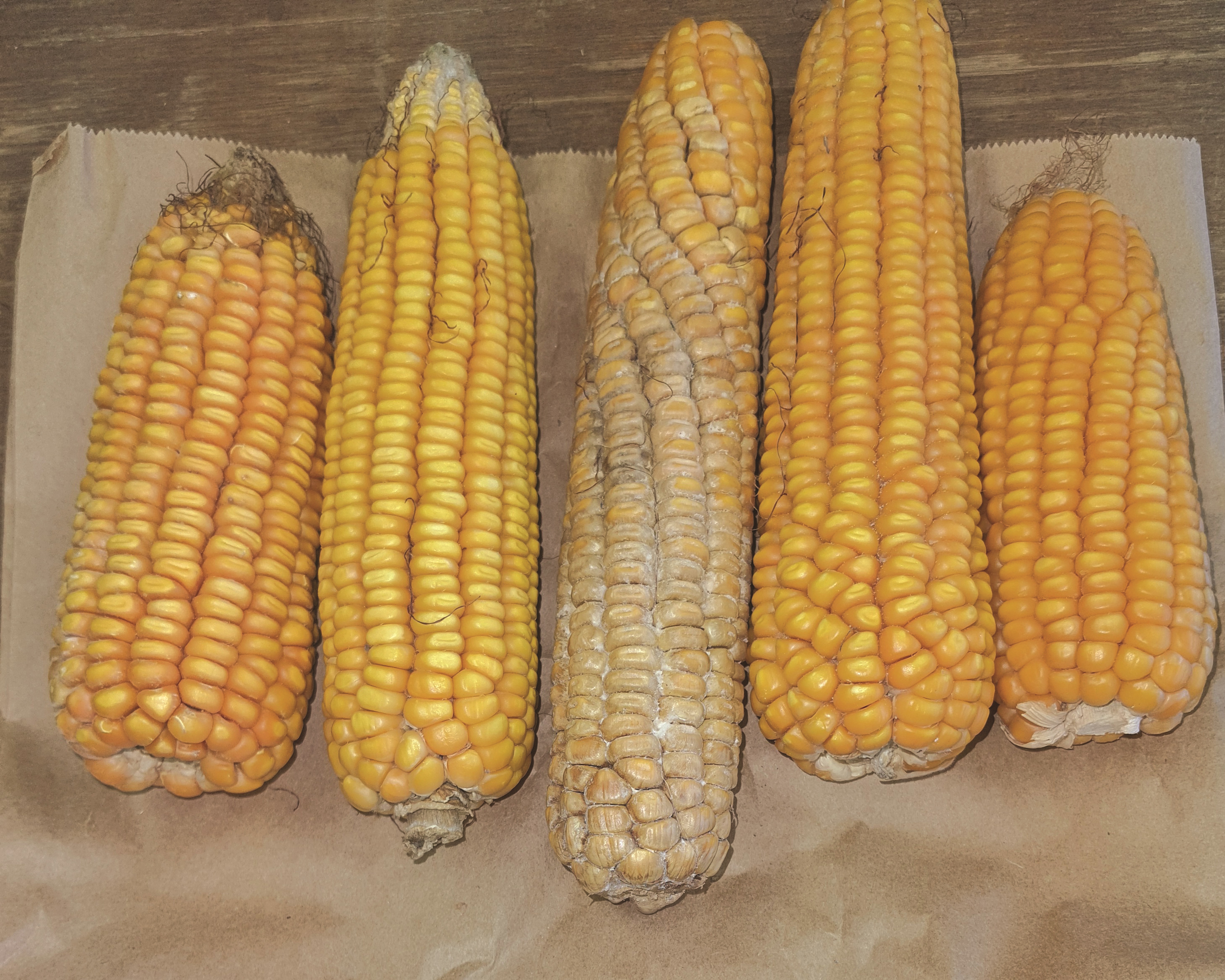
White mycelial growth on maize ear kernels caused by Stenocarpella maydis (Diplodia).
If a cross-section is made of an infected ear, these black spore-producing survival structures at the kernel bases can be seen (Photo 2). Late-season infections may occur when the kernel moisture is low, but these symptoms are less obvious. Infections that show little or no symptoms are locally referred to as ‘skelm Diplodia’.
Diplodia ear rot can re-occur in certain areas and infected grain is then harvested with the healthy grain, thereby reducing the grain quality. Reduced grain quality will have negative financial implications, as this reduces the price the producer receives for his grain.
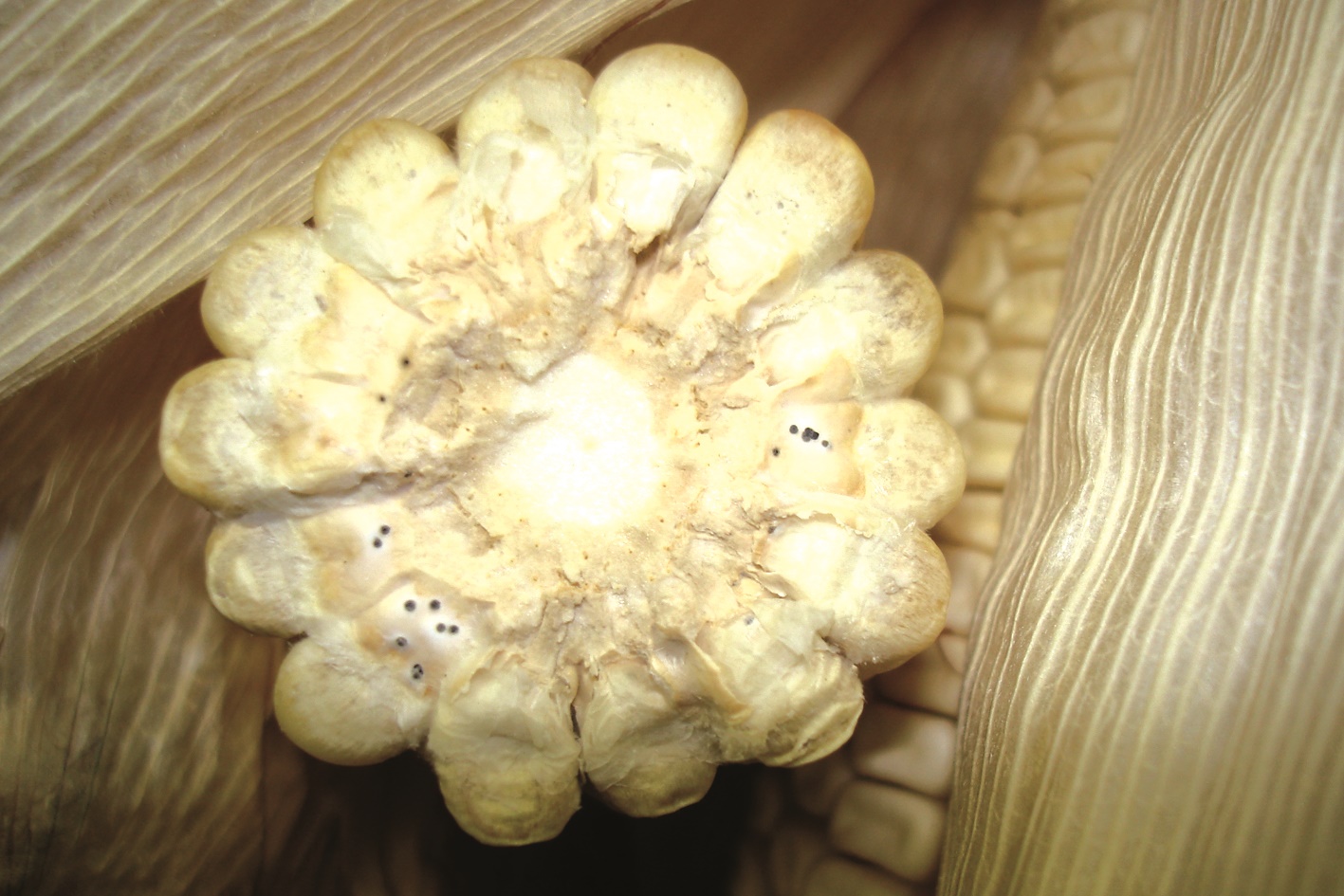
Black ‘spots’ containing spores can be seen at the base of the maize kernels.
CONTROL MEASURES
Stubble reduction/retention: The control of Diplodia ear rot includes surface stubble reduction by means of grazing, burning, baling or ploughing in of the surface maize stubble. As the fungus (S. maydis) survives on maize stubble and poorly in soil, any management practice that reduces the levels of infected surface stubble will reduce the initial inoculum concentrations in the field.
The removal of stubble for a single season and then resorting back to stubble retention practices only reduces Diplodia ear rot for that specific season. Where stubble is present during the following season, the risk of Diplodia ear rot will increase to its original level if the weather conditions are favourable.
Stress reduction: Avoid planting unrealistically high plant populations on marginal soils and in areas where there is a high probability of drought, leaf or alternate stalk rot disease conditions. Ensure that the plant nutrition is adequate and balanced relative to the yield potential of the land or area to be planted.
Crop rotation: Crop rotations reduce Diplodia ear rots by reducing the inoculum levels in two ways. Firstly, a non-host for the fungus will not allow the fungus to persist for the season where maize is not grown. Secondly, a greater period (a season or two) between maize crops allows for a natural breakdown of maize stubble, which again reduces the survival of the fungus.
Leguminous crops, such as soybeans, dry beans, groundnuts and cowpeas, are very good rotation crops. Other rotation crops that reduce Diplodia ear rots, are wheat and oats. Sunflowers do not significantly reduce Diplodia ear rots under experimental conditions, although the reason has not yet been found.
Early harvesting will reduce Diplodia ear rots as it reduces the time available for the fungus to grow on the ear. Late or winter rains keep ears wet and increase the chance for fungal growth.
Hybrid resistance: The selection of cultivars is very important. In general, a resistant hybrid will always have less Diplodia ear rot than susceptible hybrids relative to prevailing conditions.
FUSARIUM MAIZE EAR ROT
F. verticillioides can be found wherever maize production takes place and can lead to monetary loss due to poor grain quality and a reduction in the yield. Sometimes grain can be infected with the fungus without showing visible effects. Therefore it is extremely important to include a range of integrated management control strategies throughout the maize growth season.
Distribution and spread: F. verticillioides is favoured in dry, warm areas with temperatures above 28°C. Stress factors such as heat as well as insect and bird damage will exacerbate the spread of the fungus. Infection of the maize plant can occur at any time during the growth stages and often the fungus can be found within the seed. Seedborne infections can grow systemically with the plant until it reaches the ear.
This fungus is also soilborne, which means that it can survive in the soil or on plant debris from one growing season to another – thereby infecting susceptible maize when the weather conditions are conducive. Rain and wind can also splash fungal spores onto the maize beard, where it will infect and spread onto the kernels.
Symptoms of F. verticillioides ear infection is a white to light-pink cottony growth (Photo 3) on maize kernels. These can be scattered along the maize ear or can be found alongside stalk borer feeding channels. Seed can show a light-pink discolouration and white streaks.
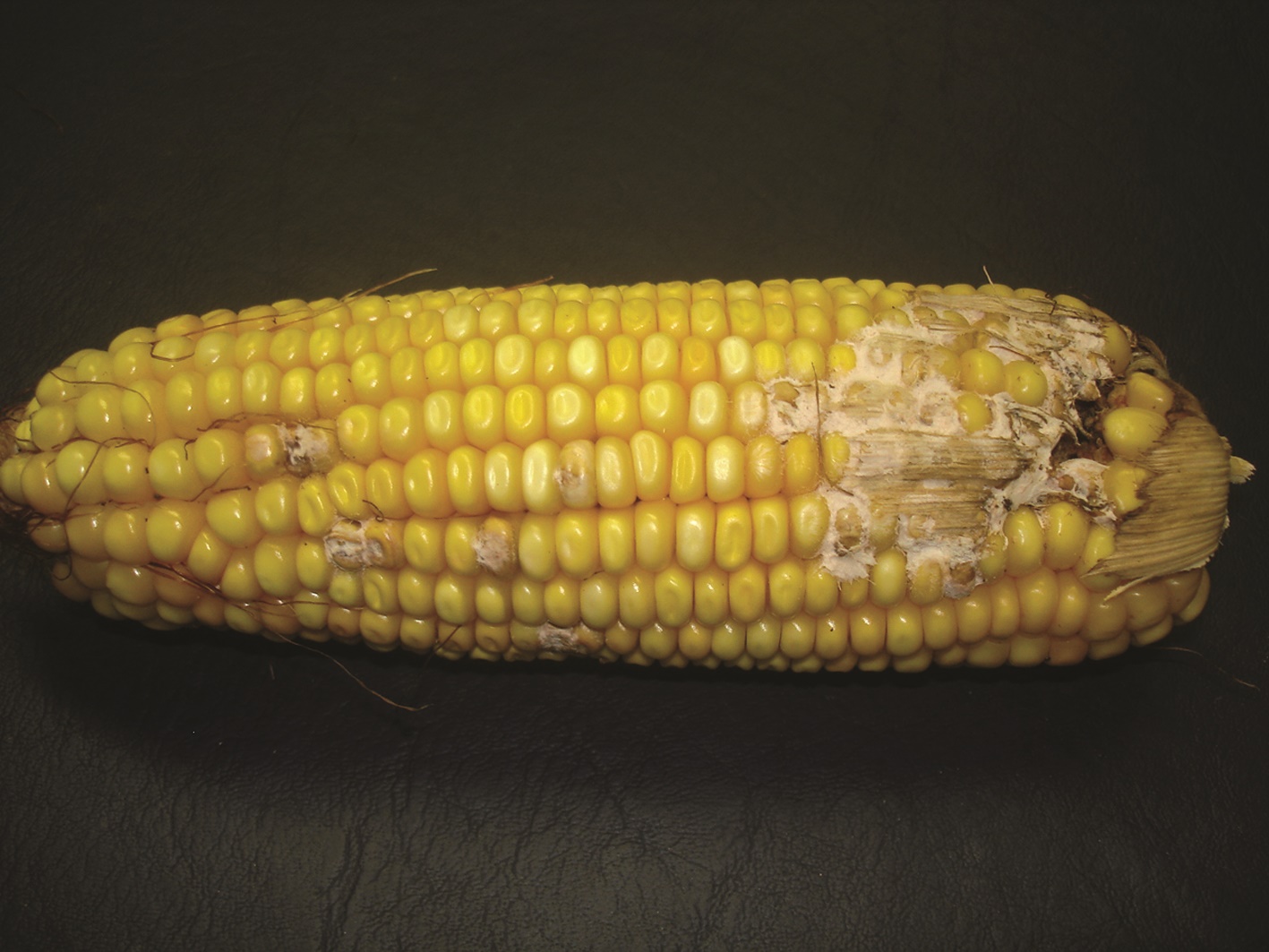
A white to light-pink cottony growth on maize kernels caused by Fusarium verticillioides.
Sometimes infection can take place, but no symptoms can be observed, and it is then difficult to determine if there are mycotoxins present in the grain or not. It has been known for clean (first-grade) grain samples to have symptomless infections of up to 90%.
Control measures: Due to the common occurrence of these fungi in nature, the use of sanitation practices has not been very successful in disease reduction. With the use of climatic modelling, Fusarium ear rot and fumonisin predictions can be made for areas with favourable climatic conditions. These models still require confirmation and further research before being used.
Recent research results indicate that the timely control of stalk borers, using insecticides or Bt maize, helps to reduce F. verticillioides ear rot infections and fumonisins. Local hybrids therefore need to be screened before hybrid selection will play a role in controlling Fusarium ear rot and fumonisin contamination levels.
GIBBERELLA MAIZE EAR ROT
Graminearum ear rot is increasing in South African maize production areas and may become a major threat to the maize industry.
Recent studies have indicated an increased spread and severity of this disease, as well as the stalk rots caused by the Fusarium graminearum species complex. In certain cases, severe yield and quality reductions were observed.
Some of the negative impacts that mycotoxins have on animals include hormonal effects (reduced reproductive performance) and feed refusal. Feed refusal is a result of the unpalatability of the feed and may be reflected in decreased weight gains and slower growth rates. Vomiting may occur in animals that consume small quantities of infected grain.
Symptoms: Disease symptoms are dark red discolouration of the whole or part of the maize ear (Photo 4). Early infections result in complete ear rotting, with husks adhering tightly to the ear. Gibberella ear rot usually progresses from the tip of the ear downward. Most often grain is discoloured and of poor quality (Photo 5), causing a lower seed grading.
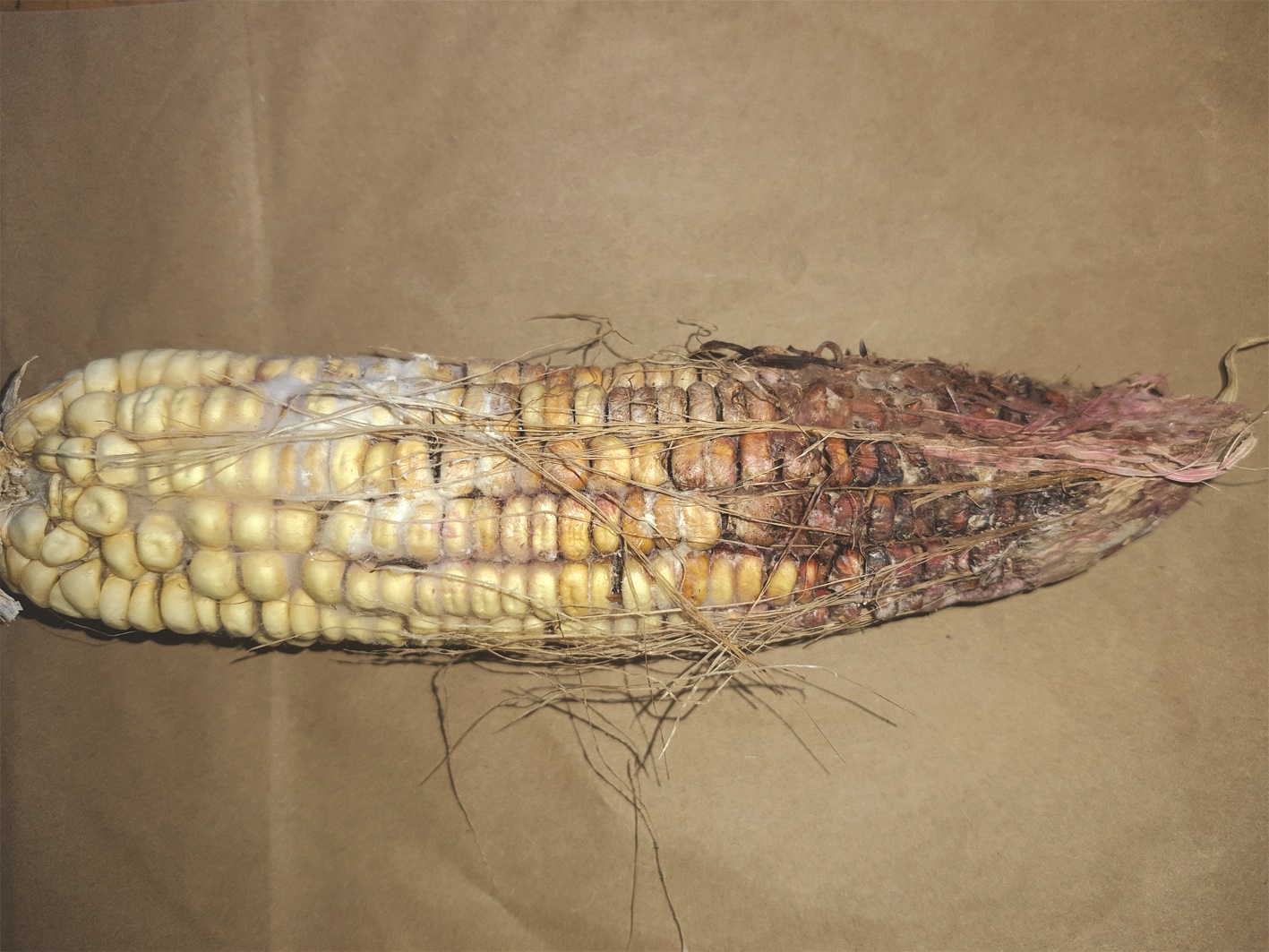
Dark red discolouration of part of the maize ear caused by Fusarium graminearum (Gibberella).
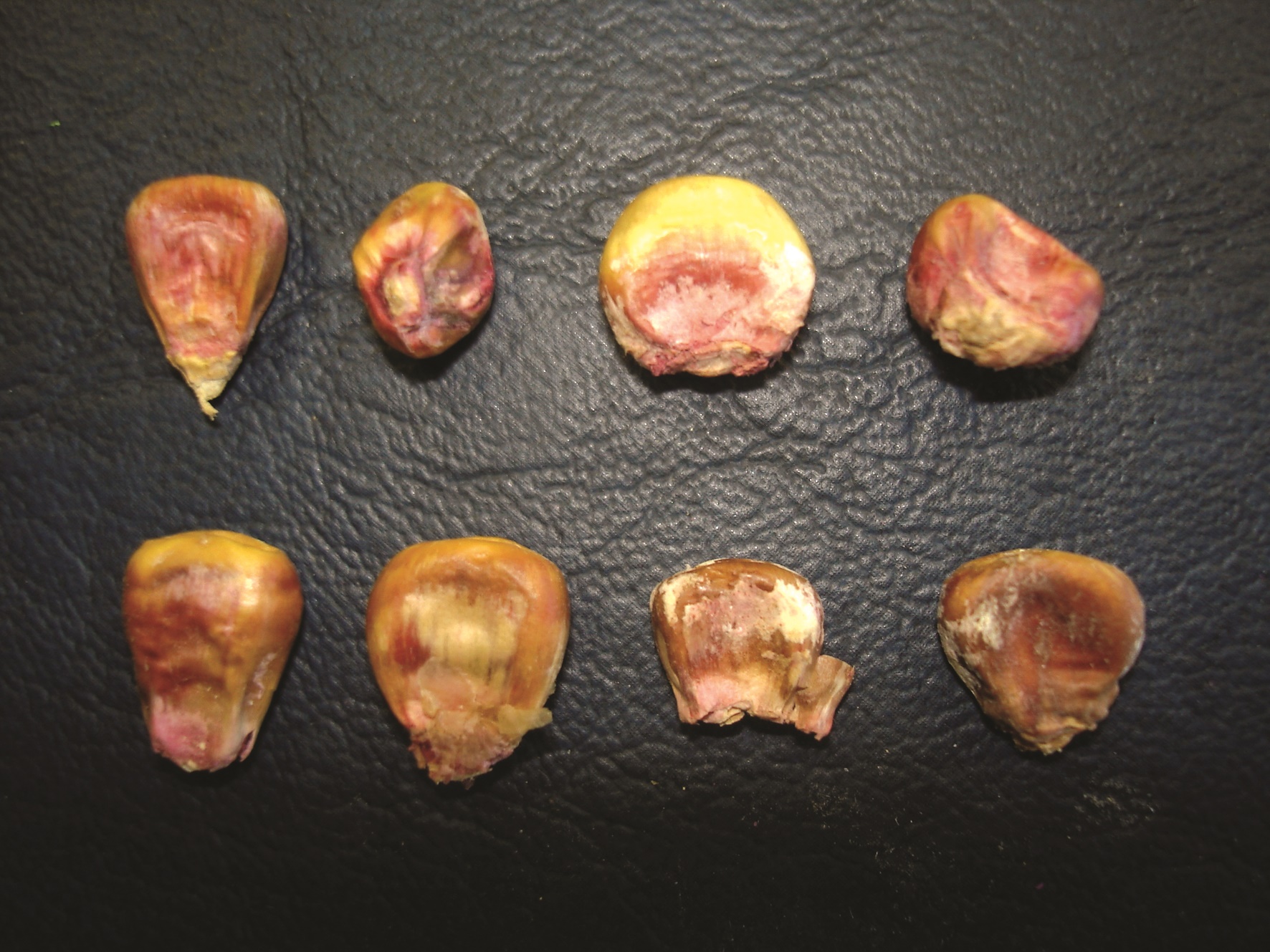
Discolouration and breakdown of grain quality due to Fusarium graminearum (Gibberella).
CONTROL MEASURES
Crop rotation: The rotation of maize with non-graminaceous crops decreases the incidence of the disease.
Stubble removal: As the fungus overwinters on maize stubble retained on the soil surface, the removal of maize residues will reduce disease incidence the following crop season. The ability for species within the Fusarium graminearum species complex to survive on other sources of organic matter and stubble of other crop species will also influence the role that the removal of maize stubble will play in reducing the inoculum sources of this disease.
Cultivar selection: Reports in the literature indicate that hybrids vary in susceptibility to the disease. Although local hybrids are presently in the process of being screened for resistance to this disease, no results are yet available. Field observations have resulted in the identification of highly susceptible hybrids.
CONCLUSION
It is important to make the correct disease diagnosis before deciding on a management strategy. In some cases, the maize crop can be infected with various diseases, which may require different management practices.
Disease management is a never-ending process. Because the above-mentioned fungi can be present in the seed, it is important to use disease-free certified seed. Usually companies treat the seed with a powder that contains an insecticide, nematicide and fungicide. This can provide protection to young seedlings for up to four weeks.
Farmers must avoid factors that stress plants, such as mechanical damage, wounding by insects and birds, inadequate fertilisers, drought and flooding, to name a few. These factors all weaken the plant’s immunity and predispose it not only to ear rots but to other diseases as well.
Please note that the use of chemicals to control maize ear rots cannot be justified economically. A fungicide may reduce the fungal spores in the environment, but it will not reach the target area, which is the fungus within the maize ear (protected by ear-sheath leaves). An integrated approach should be followed that focusses on the cultivar choice, sanitation practices and crop rotations.
For more information, contact Drs Belinda Janse van Rensburg or Bradley Flett on 018 299 6100.
Publication: February 2024
Section: Pula/Imvula